2011 HONDA FIT display
[x] Cancel search: displayPage 124 of 152

Navigation System123
Frequently Asked Questions
Map and Features, Voice Operation, Entering Addresses
Problem Solution
Why does the Disclaimer screen need to be displayed every time I start the car? I am the only driver. The Disclaimer screen reminds you and your guest drivers to always operate the navigation sy stem in a safe manner.
The Setup or Information screen has “grayed out” items that I cannot select. Why? You need to select OK on the Disclaimer screen to view these items. See System Function Diagram on page 20.
I tried entering an address, but th e city or street could not be found. Is there any other way to route to the location? Some cities are lumped in with a major metro area. Try entering the street first. In rural “unverified” areas or ne w subdivisions, streets may be missing or only partially numbered. Try selecting the destination directly from the map. See By Map Input on page 36.
When I enter an address, some letters become grayed out. Is this normal? Yes. As you enter each letter in an addr ess or a point of interest (POI), the system looks in the databa se to see what letters are possible and “grays out” letters that do not apply.
How do I delete Personal Addre sses, Previous Destinations, or the Home Address? This is done in the Setup screen (second) under “Personal Information.” See page 76.
I cannot hear the navigation system voice. 1) Ensure that Volume in the Setup screen (first) is not Off. See page 73. 2) Go to “Basic Settings” in the Setup screen (second), and set Voice Recognition Feedback to On. See page 92.
The voice control system is ha ving difficulty recognizing my voice commands. Ensure that the vents are not blowi ng on the microphone on the ceiling, the vehicle is as quiet as possible, and you are using the correct command when speaking (see Improving Voice Recognition on page 13). Say “Help” at any screen to see a list of the applicable voice commands. If the system cannot recognize your command because of background noise, speak louder.
When the system pronounces the street name in the guidance command or reads the destinati on address, it sounds strange. What causes this?
The basic guidance phrase uses a studio -recorded voice, but the street name is pronounced by the system us ing a machine-generated voice. Consequently, the name may be misp ronounced or sound strange at times.
Page 125 of 152
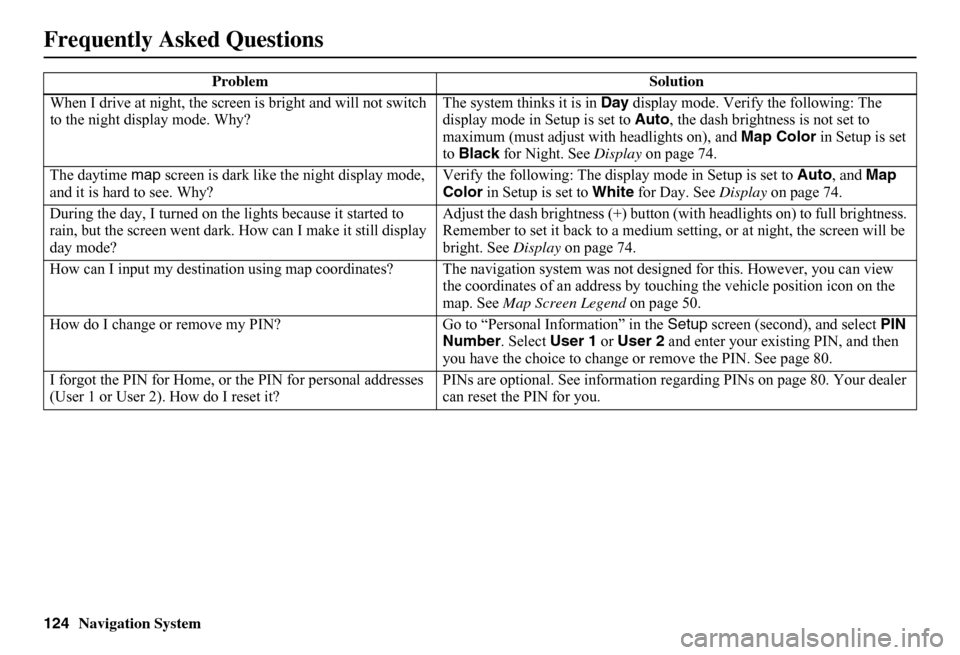
124Navigation System
When I drive at night, the screen is bright and will not switch to the night display mode. Why? The system thinks it is in Day display mode. Verify the following: The display mode in Setup is set to Auto, the dash brightness is not set to maximum (must adjust with headlights on), and Map Color in Setup is set to Black for Night. See Display on page 74.
The daytime map screen is dark like the night display mode, and it is hard to see. Why? Verify the following: The disp lay mode in Setup is set to Auto, and Map Color in Setup is set to White for Day. See Display on page 74.
During the day, I turned on the lights because it started to rain, but the screen went dark. How can I make it still display day mode?
Adjust the dash brightness (+) button (with headlights on) to full brightness. Remember to set it back to a medium set ting, or at night, the screen will be bright. See Display on page 74.
How can I input my destination using map coordinates? The navigation system was not designed for this. However, you can view the coordinates of an address by touching the vehicle position icon on the map. See Map Screen Legend on page 50.
How do I change or remove my PIN? Go to “Personal Information” in the Setup screen (second), and select PIN Number . Select User 1 or User 2 and enter your existing PIN, and then you have the choice to change or remove the PIN. See page 80.
I forgot the PIN for Home, or the PIN for personal addresses (User 1 or User 2). How do I reset it? PINs are optional. See information re garding PINs on page 80. Your dealer can reset the PIN for you.
Problem Solution
Frequently Asked Questions
Page 126 of 152

Navigation System125
Frequently Asked Questions
Guidance, Routing
Problem Solution
The navigation does not route me the same way I would go, or the way some other mapping progr am displays. Why is this? The navigation system attempts to generate the optimum route. See Changing the Routing Method on page 46.
Why is the street I’m on not s hown on the map? It has been here for more than a year. The mapping database is constantly undergoing revision. See page 103 for ways to obtain the latest de tailed coverage information.
The vehicle position icon is not following the road, and the “GPS icon” text in the upper left hand corner of the screen is white or missing.
• The GPS antenna (located under th e center of the dashboard) may be blocked by personal items. For best reception, remove items from the dashboard, such as radar detector s, cell phones, or loose articles. • Metallic tinting or other aftermarke t devices can interfere with the GPS reception. Please see your dealer. Also see System Limitations on page 98.
I entered a destination, but th e blue highlighted route and voice guidance stopped, or turned into a blue/pink dashed line before I got to my dest ination. Why is this?
Your route has entered an unverified area. See Unverified Area Routing on page 83.
The map rotates while I make turns. How can I stop this? Select the North-up map orientation by voice, or by touching the map orientation icon on the map screen. See Map Orientation on page 55.
Sometimes, I cannot select between the North-up and Heading-up map orienta tions. Why is this? The Heading-up map orient ation can only be shown in the lower scales (1/20 - 1 mile scales). See Map Scale on page 54.
While driving to my destinati on, the “time to go” display sometimes increases, even though I am getting closer. The “Time to go” is based on actual road speeds. However if your speed slows down when you encounter slower traffic, the system updates the “Time to go” based on your actual spee d to give you a better estimate of arrival time.
The vehicle position icon on the map “lags” a short distance behind, especially when I arrive at an intersection. Is there anything wrong?
No. When at an intersection, the syst em is unaware of the width of the intersecting road. Large differences in vehicle position can indicate a temporary loss of the GPS signal. See GPS Reception Issues on page 98.
Page 127 of 152

126Navigation System
While I drive, my screen s hows white dots (“breadcrumbs”) on it. What do they mean? These are called “breadcrumbs.” If you drive more than 1/2 mile from mapped roads, the off-road tracking feature begins to function. See Off-road Tracking on pages 60 and 90.
How can I get rid of the whit e dots (“breadcrumbs”) from my screen? Go to “Vehicle” in the Setup screen (second), and set Off-road Tracking to Off, then return to the map. See page 90.
A road that I selected to avoi d is being used when routing. What is wrong? When you “draw” your area to avoid, make sure to select sections of roads that include at least one intersection. See page 87.
When I arrive at my destination, the bull’s-eye is shown at a different location on the street. Why? The system calculates the bull’s-eye location based on the street address range allocated for that street. See Destination Icon on page 55 for an example.
My elevation (shown when I t ouch the vehicle position icon) seems to fluctuate even though my elevation has not changed. This is normal and due to errors in sa tellite position. The elevation can vary +/- 100 feet. See System Limitations on page 98.
My elevation is missing on th e “current position” screen. Why? If the GPS antenna cannot receive at least four satellites, the elevation is not displayed. Try moving the vehicle into an open area. If the elevation is zero or below sea level, the elev ation is also not displayed.
Problem Solution
Frequently Asked Questions
Page 129 of 152
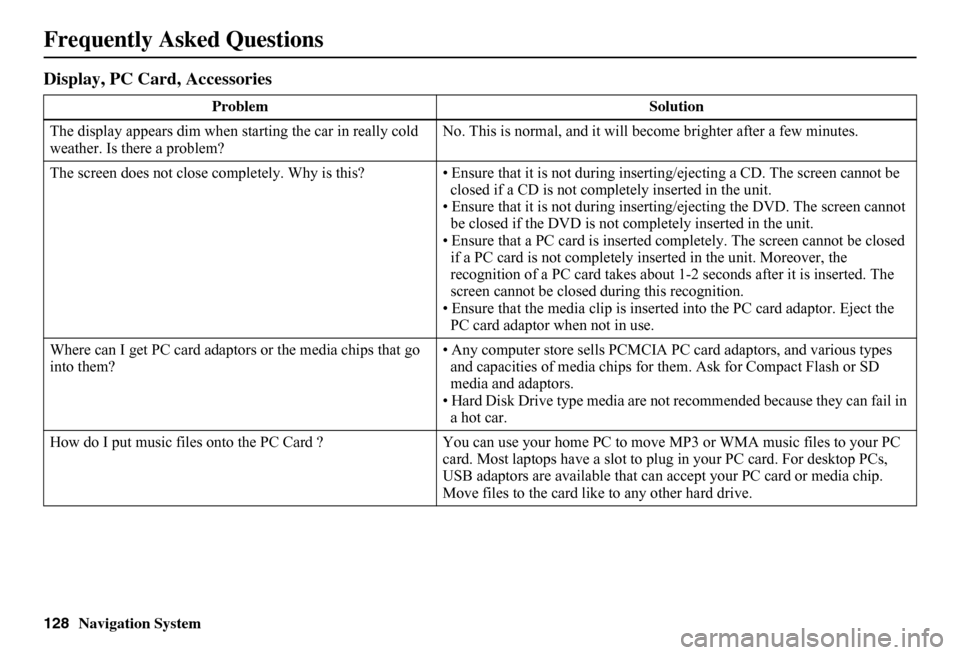
128Navigation System
Display, PC Card, Accessories
Problem Solution
The display appears dim when starting the car in really cold weather. Is there a problem? No. This is normal, and it will become brighter after a few minutes.
The screen does not close completely. Why is this? • Ensure that it is not during inserting/ejecting a CD. The screen cannot be closed if a CD is not completely inserted in the unit.• Ensure that it is not during insert ing/ejecting the DVD. The screen cannot be closed if the DVD is not completely inserted in the unit.• Ensure that a PC card is inserted co mpletely. The screen cannot be closed if a PC card is not completely inserted in the unit. Moreover, the recognition of a PC card takes about 1- 2 seconds after it is inserted. The screen cannot be closed during this recognition. • Ensure that the media clip is inserted into the PC card adaptor. Eject the PC card adaptor when not in use.
Where can I get PC card adaptors or the media chips that go into them? • Any computer store sell s PCMCIA PC card adaptors, and various types and capacities of media chips for them. Ask for Compact Flash or SD media and adaptors. • Hard Disk Drive type media are not recommended because they can fail in a hot car.
How do I put music files onto the PC Ca rd ? You can use your home PC to move MP3 or WMA music files to your PC card. Most laptops have a slot to plug in your PC card. For desktop PCs, USB adaptors are available that can accept your PC card or media chip. Move files to the card like to any other hard drive.
Frequently Asked Questions
Page 130 of 152
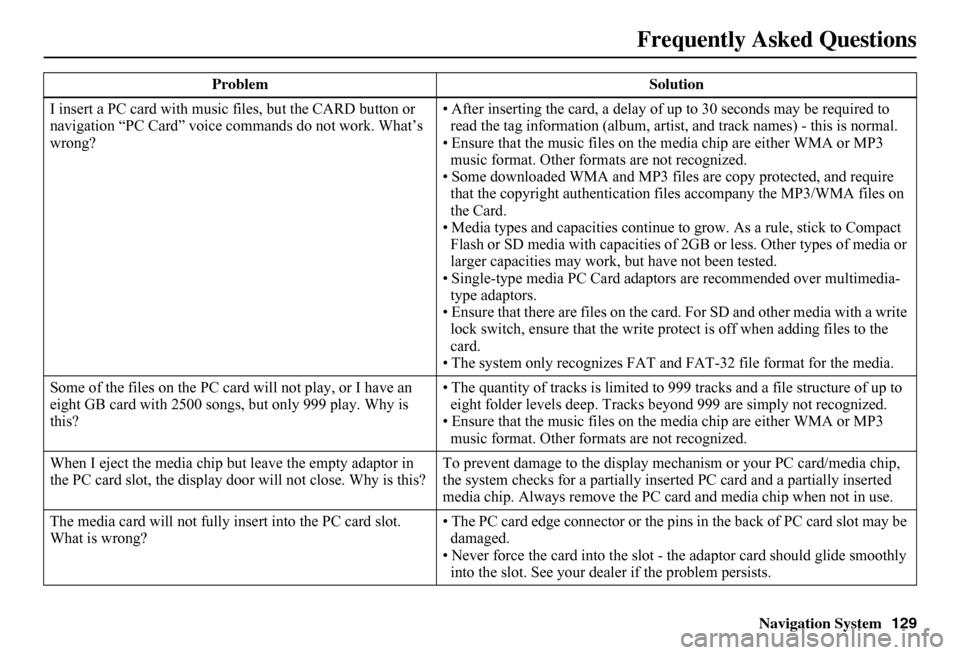
Navigation System129
Frequently Asked Questions
I insert a PC card with music files, but the CARD button or navigation “PC Card” voice comm ands do not work. What’s wrong?
• After inserting the card, a delay of up to 30 seconds may be required to read the tag information (album, artist , and track names) - this is normal. • Ensure that the music files on the media chip are either WMA or MP3 music format. Other form ats are not recognized. • Some downloaded WMA and MP3 files are copy protected, and require that the copyright authentication f iles accompany the MP3/WMA files on the Card.• Media types and capacities continue to grow. As a rule, stick to Compact Flash or SD media with ca pacities of 2GB or less. Other types of media or larger capacities may work, but have not been tested. • Single-type media PC Card adapto rs are recommended over multimedia- type adaptors.• Ensure that there are files on the card . For SD and other media with a write lock switch, ensure that the write protect is off when adding files to the card. • The system only recogni zes FAT and FAT-32 file format for the media.
Some of the files on the PC card will not play, or I have an eight GB card with 2500 s ongs, but only 999 play. Why is this?
• The quantity of tracks is limited to 999 tracks and a file structure of up to eight folder levels deep. Tracks beyond 999 are simply not recognized. • Ensure that the music files on the media chip are either WMA or MP3 music format. Other form ats are not recognized.
When I eject the media chip but leave the empty adaptor in the PC card slot, the display door will not close. Why is this? To prevent damage to the display mechanism or your PC card/media chip, the system checks for a partially inserted PC card and a partially inserted media chip. Always remove the PC ca rd and media chip when not in use.
The media card will not fully in sert into the PC card slot. What is wrong? • The PC card edge connector or the pins in the back of PC card slot may be damaged. • Never force the card into the slot - the adaptor card should glide smoothly into the slot. See your dealer if the problem persists.
Problem Solution
Page 134 of 152
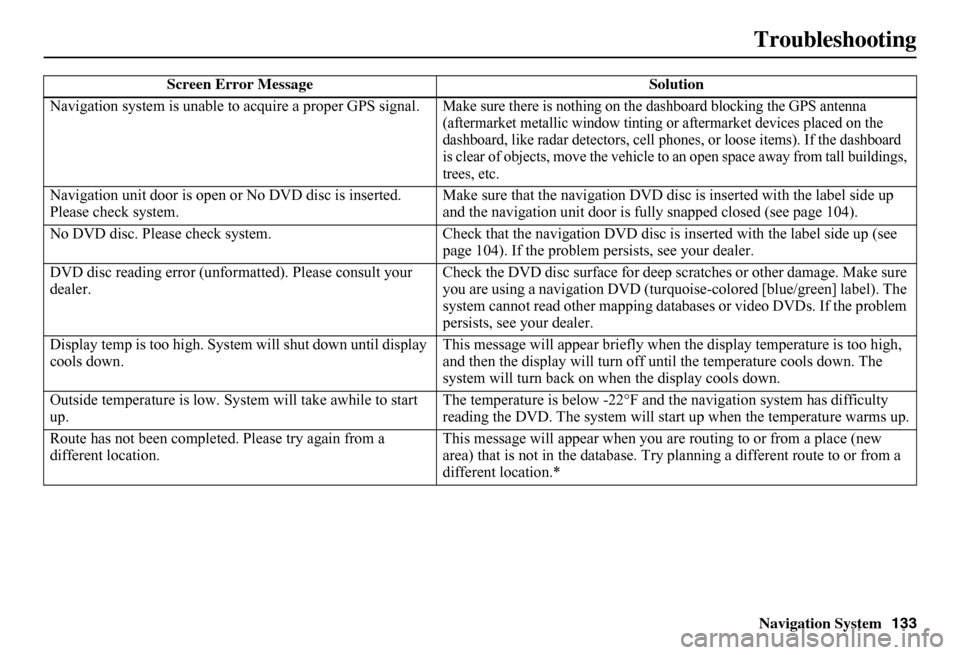
Navigation System133
Troubleshooting
Screen Error Message Solution
Navigation system is unable to acquire a proper GPS signal.Make sure there is nothing on the dashboard blocking the GPS antenna (aftermarket metallic wi ndow tinting or aftermarket devices placed on the dashboard, like radar detectors, cell phones, or loose items). If the dashboard is clear of objects, move the vehicle to an open space away from tall buildings, trees, etc.
Navigation unit door is open or No DVD disc is inserted. Please check system. Make sure that the navigation DVD disc is inserted with the label side up and the navigation unit door is fully snapped closed (see page 104).
No DVD disc. Please check system. Check that the navigation DVD disc is inserted with the label side up (see page 104). If the problem persists, see your dealer.
DVD disc reading error (unfor matted). Please consult your dealer. Check the DVD disc surface for deep scratches or other damage. Make sure you are using a navigation DVD (turquoise -colored [blue/green] label). The system cannot read other mapping data bases or video DVDs. If the problem persists, see your dealer.
Display temp is too high. Syst em will shut down until display cools down. This message will appear briefly when the display temperature is too high, and then the display will turn off until the temperature cools down. The system will turn back on when the display cools down.
Outside temperature is low. System will take awhile to start up. The temperature is below -22°F and the navigation system has difficulty reading the DVD. The system will st art up when the temperature warms up.
Route has not been complete d. Please try again from a different location. This message will appear when you are routing to or from a place (new area) that is not in the database. Try planning a different route to or from a different location.*
Page 136 of 152
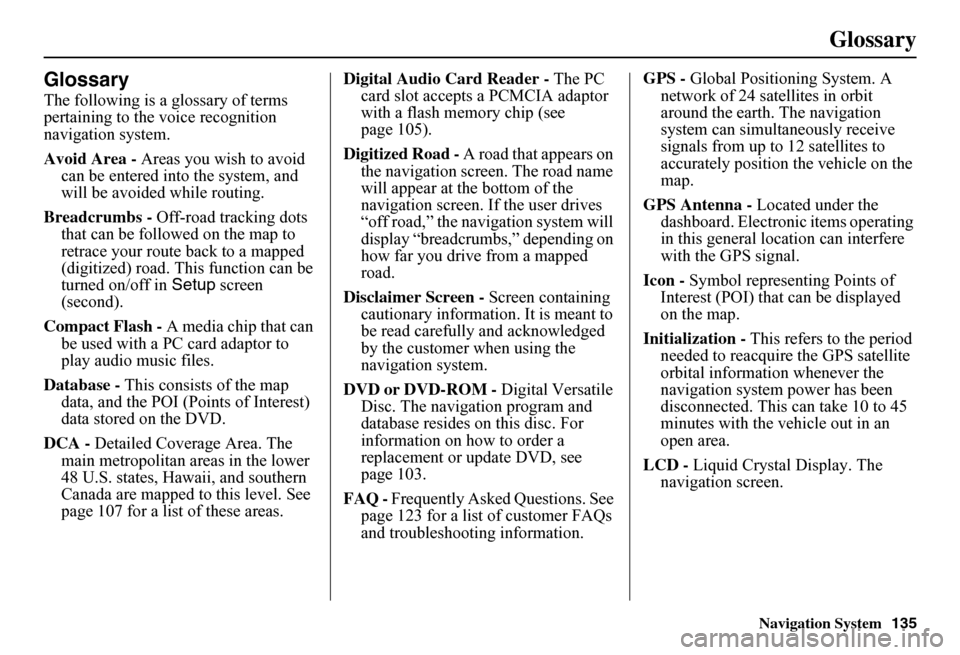
Navigation System135
Glossary
Glossary
The following is a glossary of terms pertaining to the voice recognition navigation system.
Avoid Area - Areas you wish to avoid can be entered into the system, and will be avoided while routing.
Breadcrumbs - Off-road tracking dots that can be followe d on the map to retrace your route back to a mapped (digitized) road. This function can be turned on/off in Setup screen (second).
Compact Flash - A media chip that can be used with a PC card adaptor to play audio music files.
Database - This consists of the map data, and the POI (Points of Interest) data stored on the DVD.
DCA - Detailed Coverage Area. The main metropolitan areas in the lower 48 U.S. states, Hawaii, and southern Canada are mapped to this level. See page 107 for a list of these areas.
Digital Audio Card Reader - The PC card slot accepts a PCMCIA adaptor with a flash memory chip (see page 105).
Digitized Road - A road that appears on the navigation screen. The road name will appear at the bottom of the navigation screen. If the user drives “off road,” the navigation system will display “breadcrumbs,” depending on how far you drive from a mapped road.
Disclaimer Screen - Screen containing cautionary information. It is meant to be read carefully and acknowledged by the customer when using the navigation system.
DVD or DVD-ROM - Digital Versatile Disc. The navigation program and database resides on this disc. For information on how to order a replacement or update DVD, see page 103.
FAQ - Frequently Asked Questions. See page 123 for a list of customer FAQs and troubleshootin g information.
GPS - Global Positioning System. A network of 24 satellites in orbit around the earth. The navigation system can simultaneously receive signals from up to 12 satellites to accurately position the vehicle on the map.
GPS Antenna - Located under the dashboard. Electronic items operating in this general location can interfere with the GPS signal.
Icon - Symbol representing Points of Interest (POI) that can be displayed on the map.
Initialization - This refers to the period needed to reacquire the GPS satellite orbital information whenever the navigation system power has been disconnected. This can take 10 to 45 minutes with the vehicle out in an open area.
LCD - Liquid Crystal Display. The navigation screen.